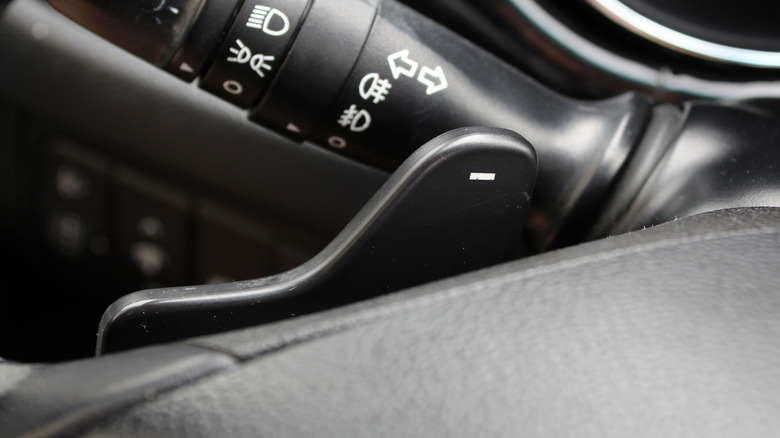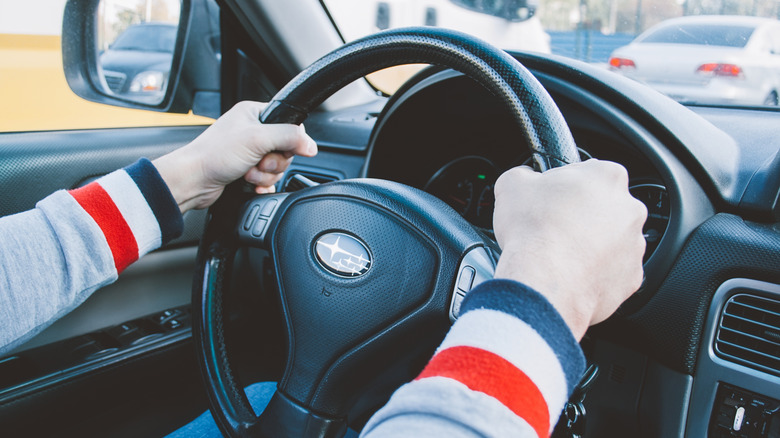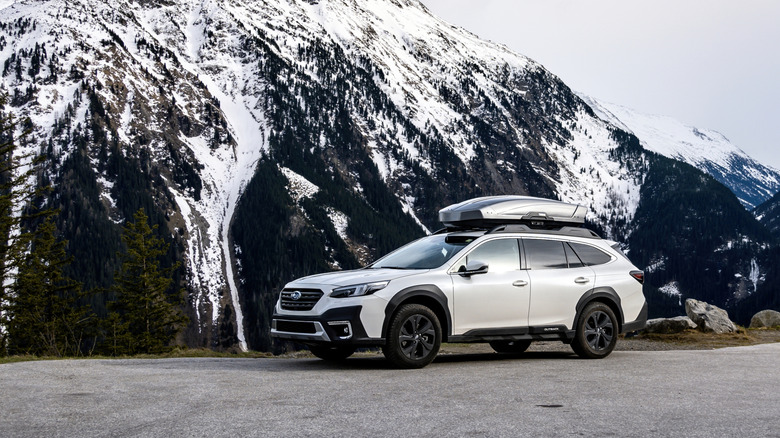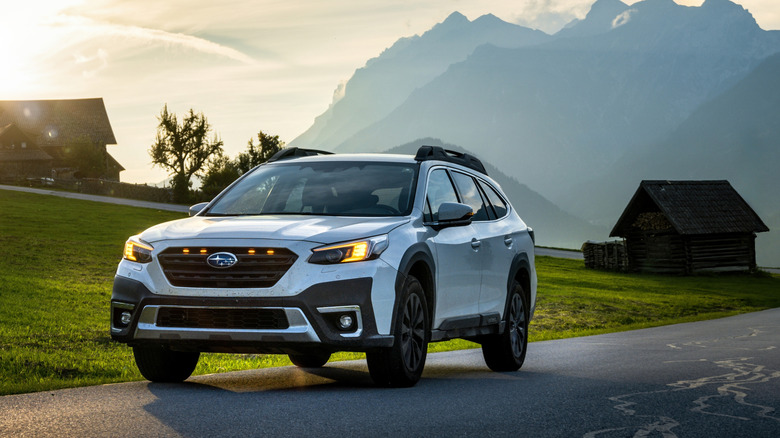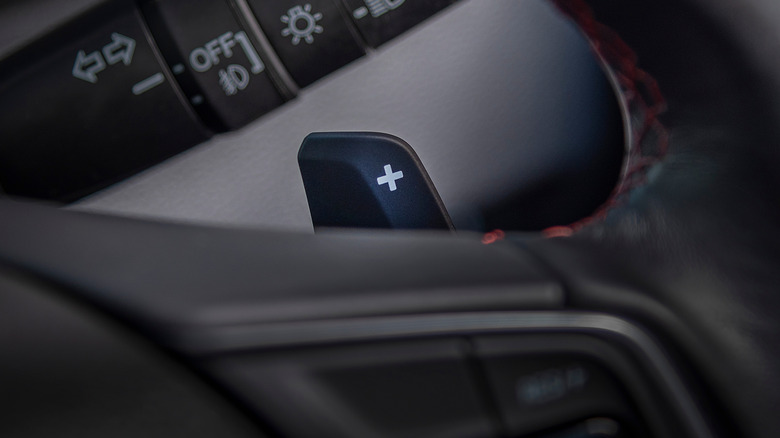How To Use Subaru's Paddle Shifters (And Disadvantages To Look Out For)
Paddle shifters, levers you can find located behind the three and nine o'clock positions on your steering wheel, are my favorite aspect of many Subaru models. They allow you to take manual control over the car's continuously variable transmission (CVT), and can be used either in manual mode, or for small lengths of time in automatic mode. Unlike shifting a real gearbox, paddle shifting can be done without taking a hand off the wheel, seamlessly changing the engine speed. They're available in many Subarus including the WRX, Legacy, Forester, Impresza, Outback and Crosstrek. I first encountered them in the 2015 Subaru Crosstrek XV Hyrbid I've been driving for nearly a decade. Once I got used to paddle shifting, I found it to be so intuitive and fun that it became a must-have feature. But for those who are unfamiliar, it can feel a bit daunting at first.
Here, we'll cover not only how to operate the paddle shifters in your Subaru, but also the most optimal times to use them — as well as how to do so in a way that's safe for you and your vehicle. From navigating steep mountain hills and inclement weather to helping you navigate everyday traffic, paddle shifting is an underused but extremely versatile part of your car's feature set. As long as you use it correctly, paddle shifting will change the way you approach some of the most common driving situations. So, here's how to use Subaru's paddle shifters, why you might want to, and what to look out for when doing so.
How to shift gears with Subaru paddle shifters
Using the paddle shifters in a Subaru is incredibly easy. The downshift paddle, marked with a minus sign, is located behind the nine o' clock position of your steering wheel, while the upshift paddle, marked with a plus sign, is located behind the three o' clock position. While driving, you can pull either paddle toward you to shift gears up or down. You will see the gear number you're in on the heads-up display centered behind your steering wheel on the dashboard, and you have six gears to choose from, ranging 1-6.
Paddle shifting behavior changes depending on what mode the car is in. In automatic "D" mode, the car will revert back to full automatic after a few seconds once speed stabilizes. In manual "M" mode, the car will remain in whichever gear you select until you change it again. Most people, especially those unfamiliar to operating manual transmissions, should remain in "D" mode for most uses of the paddle shifters.
Shifting down gives the car more torque but slows you down. This is great for making precise moves or gaining speed rapidly. Shifting up, meanwhile, reduces torque but allows for more coasting. There's not much more to the operation of the paddle shifters themselves. The trick to making this feature useful is knowing when the best times are to use it. So, here's when it can be a good idea to use Subaru paddle shifting.
Use paddle shifters for quick maneuvers
One of the most common ways to use paddle shifters is for quick maneuvers on the road, such as passing and merging. Since downshifting increases engine speed and gives you more torque, it also means lower gears help you accelerate faster. Let's say you're driving down a freeway onramp toward a high speed merge, but you're not quite up to the speed of traffic. Downshifting will make your engine roar, allowing you to get a quick boost in speed when you press on the gas and letting you claim a gap in traffic as you merge. Passing on a straightaway is another common use for paddle shifting. Let's say you're stuck behind a large truck. Put on your blinkers, downshift to a low gear, then peel off into the left lane, and you'll soon have the truck in your rearview. Remember to merge courteously, as the increased speed from downshifting can sometimes mean that you'll have a bit more pep than you expected. No one likes to get cut off by a torqued up Subie suddenly shooting out in front of them.
Cornering is another instance where paddle shifters come in handy. As you approach a bend, downshifting can help you drive more smoothly through turns. However, make sure you shift before you turn, not during the turn itself. Shifting quickly into a turn can cause the wheels to turn more slowly than the vehicle, which may be fine on a straightaway, but can cause you to spin out while turning.
Use paddle shifting to engine brake, but be cautious
One of the most common usages for paddle shifting is engine braking, which is when you move into a lower gear in order to slow down your vehicle. For example, if you're rolling toward a red light that you know is about to turn green, it would be inefficient to come to a full stop, then immediately start moving again. You can downshift as you approach the light to slow yourself, then use the increased responsiveness of the lower gear to speed back up as soon as it turns green.
Some will claim that engine breaking is hard on your engine and will damage it. This is a myth. Your CVT Subaru engine is designed to engine brake within reason, and it even has some built-in failsafes to prevent you from harming the engine. Your paddle shifters won't work if you shift up or down too early, shift while the vehicle isn't moving, or pull both paddles simultaneously. However, there are some things to keep in mind. You should make sure your engine speed doesn't climb up to a dangerous number of RPM, which means you should avoid shifting at high speeds. Be careful not to shift more than one gear in quick succession. You also shouldn't overuse engine braking, so if you're stuck on a road where you're hitting every red light, don't start engine braking on every block.
Use paddle shifters for towing and mountain driving
If you live in an area with lots of hilly or mountainous terrain, you may find yourself driving along a number of steep grades. Most people know that pumping your brakes rather than riding them is the correct tactic to approach long sections of downhill road without wearing out your brakes. But if you have a Subaru with paddle shifters, you can use them to engine brake by shifting into a lower gear. This can help to keep your vehicle moving at a steady pace without gaining too much speed on a long downhill where control is important, and it will help to avoid wearing out your brakes.
Another use for paddle shifting is in slippery terrain like rain or snow. Here in Colorado, I get a lot of use out of my Subaru Crosstrek XV's paddle shifters during the winter months. When you're parked in deep snow and worried about getting stuck, downshifting to a low gear provides added torque and control. You can also use manual shifting with paddles for better control in rainy conditions with slippery roads. However, exercise caution when you paddle shift in inclement weather
Things to keep in mind when you paddle shift a Subaru
The more you use your Subaru's paddle shifters, the better you'll get at knowing when and how to do so. Before you know it, you'll be using them almost without thinking, as a natural part of your driving habits in the most reliable Subaru models. However, there are a few things to keep in mind as you learn, so that you don't develop bad shifting habits that can harm your Subaru.
Do not shift more than one gear at a time, give your Subaru's engine time to adjust before shifting again. Do not keep your engine at a high RPM — 2,500 RPM is generally the limit, and you should shift up when your engine exceeds that figure. If your engine redlines (meaning the RPMs reach an area denoted by the red line on the gauge), shift up or return to automatic mode immediately.
If you paddle shift before a turn, make sure you do not shift as you enter the turn, but rather do so before you turn the wheel. It is always best to shift while going straight to avoid getting on the wrong side of the laws of physics and spinning your vehicle.
You should also be aware that, because your CVT is always looking for a fuel-efficient speed, taking manual control by paddle shifting will burn more fuel than leaving the vehicle in fully automatic mode at all times. However, you'd have to be shifting quite frequently to burn a noticeable amount more fuel.

